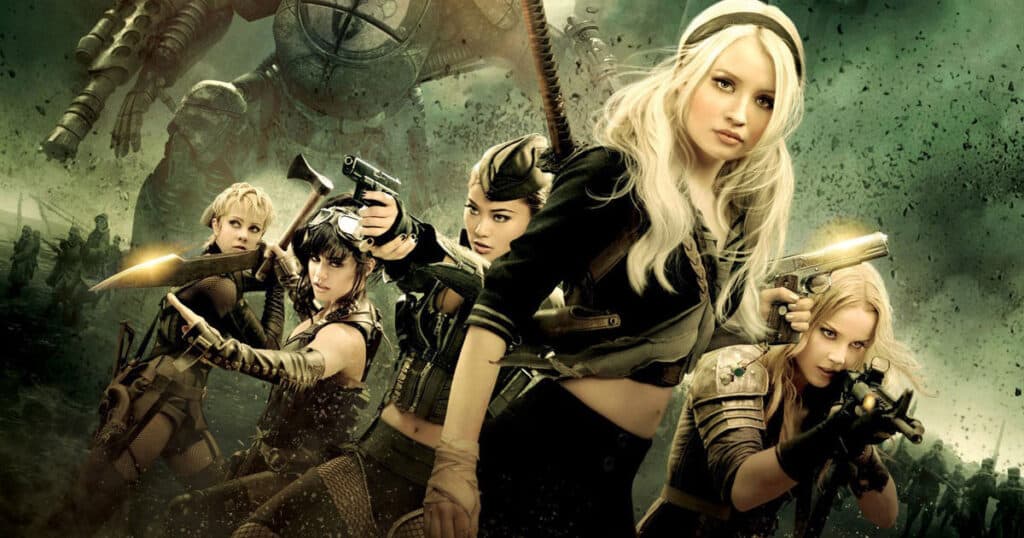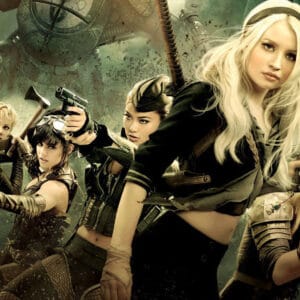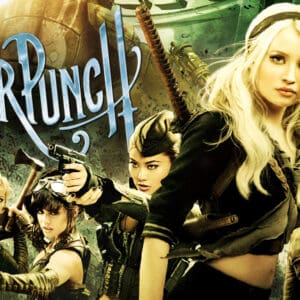Last Updated on June 26, 2024
When Zack Snyder’s Sucker Punch premiered in 2011, it was met with a polarizing reception. Critics and audiences were off-put by its unique style, ambitious narrative structure, and the way it blended genres. As someone who initially viewed the film through a less mature lens, I found myself unimpressed by its convoluted plot and perceived lack of substance. Hell, I even watched it twice upon release to make sure I wasn’t missing anything. As time went on, I had moved on from the stale taste it bestowed upon me. So much so that I had even skipped any future Snyder offerings, yes, this includes his DCEU output. Maybe I’ll get to those one day. Who knows? However, one thing I do know is for certain: Zack Snyder loves himself a director’s cut of his films. Recently, he has expressed his determination to give his first original film the ol’ Snyder Cut treatment, even going as far as to say he has footage already shot for it. So, it got me thinking. Was this movie as bad as I remembered it? Or would my more mature eyes see something in this picture I missed on my initial viewings? Let’s see if the third time’s a charm as I revisit Sucker Punch thirteen years later.
THE SETUP
Like many of us, Zack Snyder first came onto my radar in 2004 with his remake of Dawn of the Dead. I vividly remember sitting in the theater when the trailer for that film came on. At the end of it, several people in the theater groaned (myself included) at the audacity of remaking George Romero’s zombie magnum opus. Cut to the opening day, and I was thoroughly surprised by how great it was, especially with the incredible beginning.
This was a man to watch.
He followed that film, sans writer James Gunn, with the smash hit adaptation of Frank Miller’s 300. It made well over the total gross of Dawn of the Dead and even made Gerard Butler’s King Leonidas meme-worthy. I mean, everywhere you turned, someone was parodying, “This is Sparta!” It was a global phenomenon. His next film would be yet another adaptation of a classic graphic novel – one that would begin the divisiveness amongst fans: Watchmen. Coming from a guy who has devoured Alan Moore’s epic multiple times, I’ll tell you all right here and now: I love his take on Watchmen, especially the director’s cut. I can already feel myself getting ripped to shreds from many just by admitting that. However, I’ll save my defense on it for another day, maybe just before the doomsday clock strikes twelve.
In 2011, though, Warner Bros. gave the world the chance to see what a Zack Snyder film would look like based on an original story and not having to piggyback from classic material. And the results were, well, let’s just let the box-office numbers speak for themselves. ($89,792,502 Worldwide)
REVIEW
Sucker Punch stars Emily Browning as Babydoll, a young woman institutionalized by her abusive stepfather. Facing a lobotomy, Babydoll retreats into a fantastical dream world where she plots her escape alongside fellow inmates Sweet Pea (Abbie Cornish), Rocket (Jena Malone), Blondie (Vanessa Hudgens), and Amber (Jamie Chung). The film operates on multiple narrative levels: the grim reality of the asylum, a stylized brothel setting where the characters envision themselves, and a series of extravagant, action-packed fantasy sequences.
Color me intrigued.
Based on the previous three mentioned films, I was already sold on this film (I never saw his animated Owls movie). Even a good friend of mine sang its praises before I could see it by saying it was his all-time favorite movie. No shit. Then I saw it. My first response was to call him and curse him out for leading me to believe I was in for the greatest movie ever made. He made his defenses, and I listened, not agreeing with a single word said. Maybe I had missed something. I gave it one more chance shortly after. That time was a more enjoyable experience, but not for the reasons Mr. Snyder would have hoped for. That time, it was while hanging on a tour bus with a popular metal band after a show. We shared drinks, threw on Sucker Punch, and laughed hysterically at how bad it was. It was a glorious misfire on all calculations. After that, I told myself, never again. Now, I know I sound like I was a pretentious little punk, and you’d be very much correct. But since I’m more aware of myself, I feel I offer Mr. Snyder another chance. This time, I’m giving the not director-approved extended cut a shot.

So here we go.
The first thing that surprised me was how great the opening was. Sure, it has that signature slow motion Zack Snyder overly uses in every film, but it’s so damn gloriously shot I can forgive it. The film begins with a haunting montage that introduces us to Babydoll’s tragic backstory, unfolding almost like a silent film with minimal dialogue but powerful imagery and a haunting rendition of “Sweet Dreams (Are Made of This),” performed by Emily Browning herself, as its backdrop. You can’t deny Zack Snyder is a hell of a visual storyteller. In those five minutes, we see Babydoll’s mother pass away, her stepfather’s malicious intentions, and the horrific event that led to Babydoll being institutionalized. The lack of dialogue in these moments forces us to focus on the visual and emotional cues, creating a sense of urgency and helplessness. Snyder uses close-ups and dynamic camera movements to heighten the emotional impact, capturing the raw emotions on Babydoll’s face and the sinister expressions of her stepfather. The climax of this sequence, where Babydoll accidentally kills her younger sister while trying to defend her from their stepfather, is heart-wrenching. This moment, rendered in slow motion with Babydoll’s anguished face, is just great stuff.
Then, the rest of the movie happens.
After a killer opening, Babydoll is sent to a mental institution by her stepfather. She overhears her stepfather convince the asylum’s director, Dr. Blue Jones (Oscar Isaac) to forge a signature to grant a lobotomy. To escape the harsh reality of the asylum, Babydoll Pan Labyrinths herself to a high-end brothel where she and the other inmates are dancers. In this fantasy, the girls are forced to entertain clients but also find a semblance of camaraderie and solidarity. Babydoll meets four other girls: Sweet Pea, Rocket, Blondie, and Amber. Together, they plot to escape, with Babydoll devising a plan that requires collecting five items: a map, fire, a knife, a key, and a mystery item that will be revealed later.
However, in order to retrieve these items, Babydoll must dance for her captors to create a diversion. It is within these dance numbers that Babydoll yet again creates another layer of imagination where she and her friends are warriors on a mission. Guided by the Wise Man (Scott Glenn), each quest for the items translates into an action-packed battle sequence. These sequences are set in various fantastical environments: a feudal Japanese temple where she fights giant samurai warriors, a World War I battlefield with an army of steampunk zombies, a medieval castle guarded by a dragon and orcs, and a futuristic train carrying a bomb. As the girls progress through their quests, the lines between reality and fantasy blur.
As great as all of this sounds on paper, it is frustrating sometimes. How can a movie with steampunk nazi-style zombies, orcs, dragons, giants, robots, and high-powered trains be so boring? Yet, on one hand, as a positive note to compliment the negative, the film’s blend of steampunk, anime, and video game influences creates a unique and immersive world. Each fantasy sequence is meticulously crafted, offering a sensory overload of epic battles, otherworldly landscapes, and intricate set pieces, even if the overuse of CGI is shoddy at times. On the other, not all the delivery exactly lands from the girls. That’s not to say these are all bad actors. Mostly, it’s far from it. Maybe it’s intentional, but the way lines are delivered here is as if it were taken from a B-grade 70’s exploitation film.
However, already knowing the movie’s outcome from my previous two viewings had me begging the question: are all of these scenes, including the brothel world, pointless? Is it the equivalent of “it all being a dream” ala Vanilla Sky? Okay, that one may be debatable, but you know what I mean. With each dance sequence, I found myself rolling my eyes and saying, “Here we go again,” as my younger version would say. But this time, something changed, and I saw something I never let that young punk see.
Initially, this narrative complexity felt disjointed and confusing, as if it were written as a fantasy by a 13-year-old gamer. However, with time and reflection, the structure reveals itself as a commentary on escapism and the power of imagination in coping with trauma. The layering of reality and fantasy illustrates Babydoll’s desperate bid for freedom and control in a world that has stripped her of both. Although the transitions between these layers can be jarring, they are integral to the film’s exploration of the mind’s capacity to seek refuge in illusion.
The labyrinth structure also functions as a metaphor for Babydoll’s mental state. Each fantasy sequence corresponds to a step in her escape plan, with completing each task bringing her closer to her goal. This narrative device, while ambitious, can be challenging, for sure. Yet, it is this very complexity that underscores the film’s thematic exploration of the interplay between reality and imagination. At its core, Sucker Punch is a story about empowerment. The female protagonists, initially portrayed as victims of a brutal system, gradually assert their agency and fight back against their oppressors. This transformation is symbolized through Babydoll’s fantasy sequences, where she and her companions become fierce warriors. Each mission they undertake in these sequences is a metaphor for their struggle to regain control over their lives. Despite their initial helplessness, the characters’ resilience and determination shine through, highlighting the theme of inner strength and empowerment. The setting of the brothel fantasy is a deliberate choice to critique the objectification and exploitation of women. In this layer of fantasy, the girls are not just inmates but performers in skimpy clothing, expected to cater to the desires of their male clients. This setting amplifies the film’s commentary on how society views and treats women, often reducing them to mere objects of desire. However, within this framework, the girls find ways to subvert their roles and reclaim their power, reflecting the broader theme of resistance against objectification.

This leads me to the question I asked myself when I first saw the movie: what the hell is up with the title?
The title Sucker Punch itself carries significant meaning and encapsulates the film’s themes. A “sucker punch” is an unexpected blow, often delivered when the recipient is unprepared. This term can be interpreted in several ways within the context of the film.
Firstly, it reflects the unexpected strength and resilience of the female characters. Despite being perceived as powerless, they deliver a metaphorical “sucker punch” to their oppressors by fighting back and asserting their agency. This unexpected resistance is a central theme, as the characters defy the roles imposed upon them and take control of their destinies.
Secondly, the title also alludes to the film’s narrative structure and its impact on the audience. The abrupt shifts between reality and fantasy and the ultimate reveal of Babydoll’s sacrifice can be seen as a “sucker punch” to the viewer, challenging expectations and forcing a deeper reflection on the story’s themes.
Lastly, the title can be interpreted as a commentary on the film’s reception and the societal norms it critiques. The film’s overtly stylized presentation and controversial themes deliver a figurative “sucker punch” to conventional cinematic expectations, pushing the audience to reconsider their perceptions of empowerment, trauma, and fantasy. That’s just my two cents.
If only it were in better hands or a different scribe. As I said, Snyder is one hell of a visual storyteller. But in this case, it feels this is more style over substance. The blending of reality and fantasy, while thematically significant, can be disorienting and detract from the narrative coherence. The lack of character development for most of the supporting characters also hampers the film’s emotional impact. Unfortunately, the stunning visuals completely undermine the initial message of the movie.
Is Sucker Punch as awful as I remembered it to be? No. I’d say it has definitely gotten better with age, although not by much. If you take this movie as is and think of it as a big-budget, fantastical “women in prison” exploitation film with a deeper message, then you may find some enjoyment in it. And once Mr. Snyder delivers his promised definitive version, I’ll return to his world and give it the same attention it deserves.




















Follow the JOBLO MOVIE NETWORK
Follow us on YOUTUBE
Follow ARROW IN THE HEAD
Follow AITH on YOUTUBE